The 2013 MacBook Air Review (11-inch)
by Vivek Gowri on August 9, 2013 1:45 AM ESTThe performance story is a bit interesting. There are two sets of 15W Haswell ULT parts, some with HD 4400 (GT2) and others with HD 5000 (GT3) onboard graphics. The GT3 parts, in order to hit the same TDP, run lower clock speeds. Apple chose to go for GT3 across the board. This isn’t the first time that Apple has made the decision to sacrifice CPU performance for the sake of GPU, but this was probably a pretty easy choice for them compared to 2010, when they skipped Arrandale on the 13” MacBook Pro and Airs for Penryn-era Core 2 Duo and Nvidia’s G 320M. That particular IGP was pretty fast, so much so that the substantially improved HD 3000 that came with the Sandy Bridge mobile parts was actually a bit of a downgrade on them.
The CPU tradeoff here is substantially less than it has been in the past, so this is a bit of a no-brainer. The i5-4250U in the base 2013 MacBook Air is clocked at a low 1.3GHz but has the same 2.6/2.3GHz (single core/dual core) turbo clocks as the 1.6GHz i5-4200U with GT2 graphics. The clock speed difference is even less at the high end: the optional i7-4650U is clocked at 1.7GHz and turbos to 3.3/2.9GHz while the fastest GT2 ULT part, the i7-4500U, runs 1.8/3.0/2.7GHz. The hit you take on base clock is pretty easy to justify for the more powerful GPU.
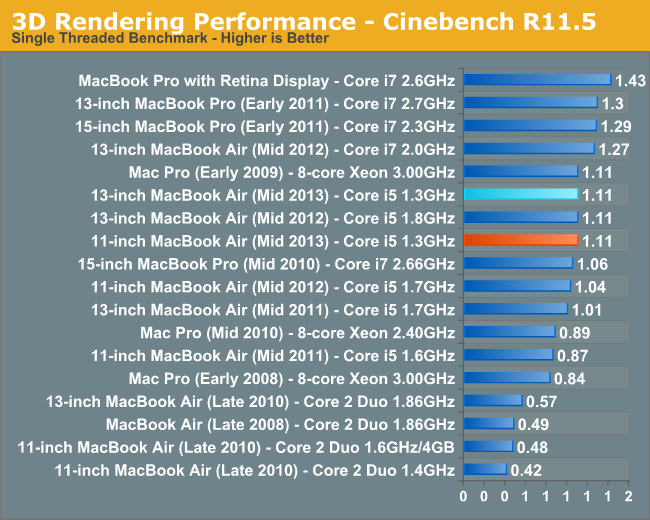
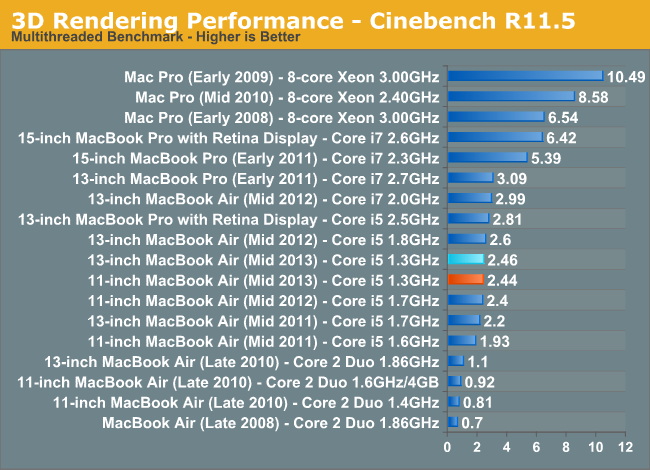 With that said, the raw performance isn’t really that great. The 13” Air that Anand reviewed was slower than its immediate predecessor, which used a 1.8GHz i5-3427U. The base 11” last year used an i5-3317U (1.7GHz) and that’s actually not a whole lot faster than the 11” Air I have here. The results are basically all within margin of error for the tests, so I’m content to call it basically even with last year’s model. The Air isn’t slow, but it can certainly get pokey at times. This is no different than any Ultrabook-class machine, but worth noting. Turbo and the very fast SSD keep things going smoothly in normal day-to-day tasks, but anything substantially more intensive than a browser and iTunes is going to be outside the comfort zone of a system like this.
With that said, the raw performance isn’t really that great. The 13” Air that Anand reviewed was slower than its immediate predecessor, which used a 1.8GHz i5-3427U. The base 11” last year used an i5-3317U (1.7GHz) and that’s actually not a whole lot faster than the 11” Air I have here. The results are basically all within margin of error for the tests, so I’m content to call it basically even with last year’s model. The Air isn’t slow, but it can certainly get pokey at times. This is no different than any Ultrabook-class machine, but worth noting. Turbo and the very fast SSD keep things going smoothly in normal day-to-day tasks, but anything substantially more intensive than a browser and iTunes is going to be outside the comfort zone of a system like this.
Considering the power efficiency though, getting similar performance to the old model even with 30% slower base clocks is a decent bargain, particularly when accounting for the increase in GPU and storage performance. I’m not going to go too far into those, since Anand did a really deep dive in his 13” Air review. It’s worth noting that while his Air had a Samsung SSD, the supplier lottery churned out a SanDisk SSD in my unit. The switch to PCIe SSDs really does make itself felt in day to day use, particularly in sleep/wake situations, as well as when launching particularly large applications (that then crawl their way through the power-sipping i5 ULT). I honestly didn’t expect that, given how accustomed I’ve become to the responsiveness of fast SSDs in general, but it’s pretty important to the MacBook Air simply in terms of keeping the system feeling quick to the touch.
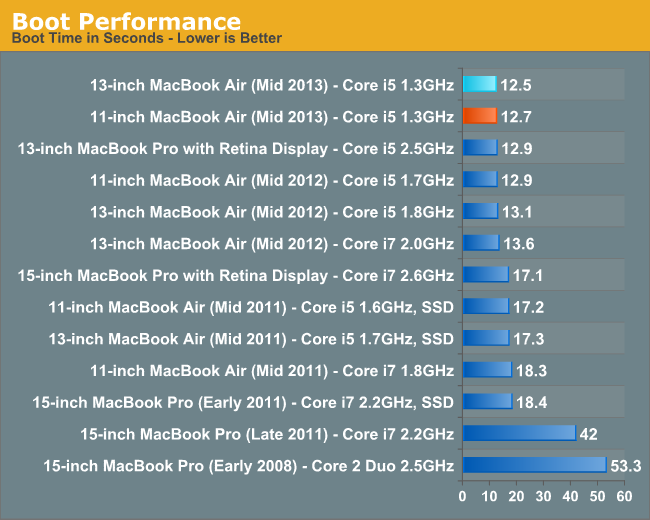

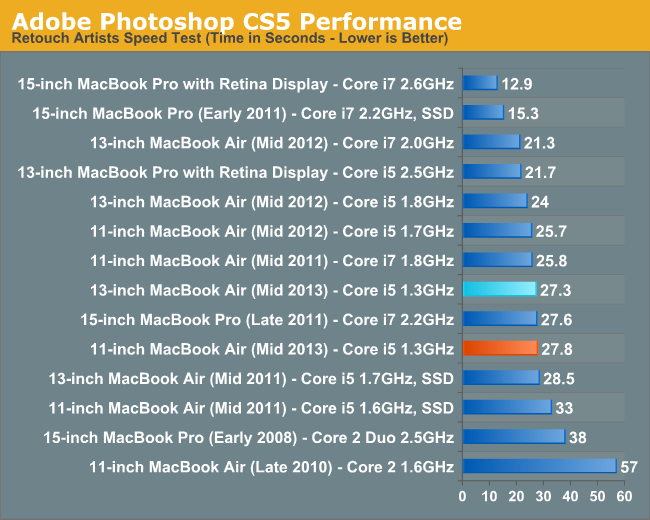


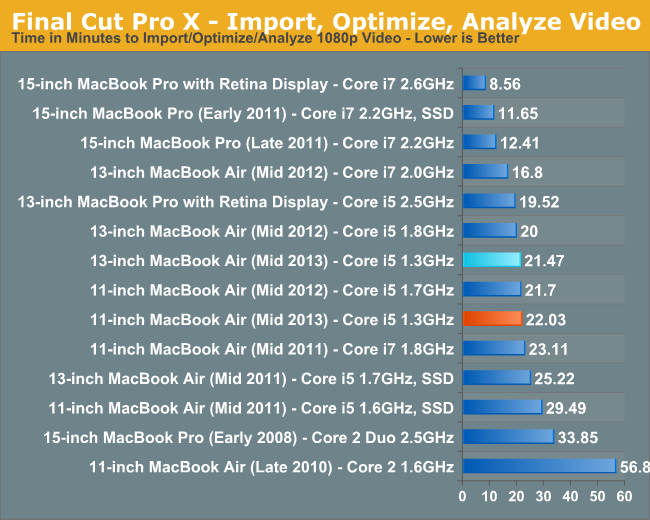










139 Comments
View All Comments
DigitalFreak - Friday, August 9, 2013 - link
"Higher screen res typically comes at the expense of poorer battery life. Apple simply made a judgement call to prioritize PROFIT over everything else. I don't see that as an inherently bad thing."solipsism - Friday, August 9, 2013 - link
And yet they've been pioneers to add high-density displays to nearly their entire line when most people on this site were saying how pointless it was. It's apparently more difficult than you give it credit or the Samsung Ativ Book 9 wouldn't be considerably higher priced than a comparably specced MBP.DesktopMan - Saturday, August 10, 2013 - link
Displays aren't actually very expensive. Look up retina screens on eBay. Samsung is charging that because they think they can, not because they have to. IMO the Ativ Book 9 is priced too high for success.ananduser - Saturday, August 10, 2013 - link
Cut the crap with the "pioneering" please. They only provided the first leak of a pissing contest in display panels. Sony's quantum dot tech present on their Vaios is pioneering, the iphone was pioneering; paying Samsung/LG to provide you high res panels is NOT pioneering.solipsism - Saturday, August 10, 2013 - link
Sure it is. Investing in a technology that a vendor saw no route for monotizing is moving technology forward. History has shown that it's not enough to simply have created a technology but you need to have an application that can effectively utilize it. Just within the the recent years of Apple we've seen Intel dust off their SFF ULVs to make them the basis of an entirely new Ultrabook™ brand under Intel, we've seen Corning retrofit a factory to make alkali-aluminosilicate sheet for the original iPhone that they then branded as Gorilla Glass® despite their CEO reportedly telling Steve Jobs it could not be done, we've seen Apple become in the most profitable handset vendor in the world in a little over a year of reaching the market despite claims from Blackberry (nee Research In Motion) that the iPhone OS couldn't be that smooth as well as the entire industry moving to a multi-touch capacitance touchscreen.What's amazing is that you could claim that none of those involve new ideas or methods which means that even Google hasn't pioneered search, email, other web-based apps, and ad placements simply because they all existed in some rudimentary and less useful ways prior to Google's involvement.
ananduser - Saturday, August 10, 2013 - link
You went way overboard. I did credit the iphone. There is nothing pioneering in being the first to fit a high res display in a laptop or a high res display in a smartphone(Sony and Sharp). It's like being the first to make a carbon fiber laptop, it's not pioneering.solipsism - Saturday, August 10, 2013 - link
Yes, it is pioneering to be able to source components (which you often invest heavily in years prior) that you then mass produce before anyone else. You can claim all you want that Sony demoed or shipped a smartphone in Japan with more pixels or a higher PPI at CES before Apple released the iPhone but that isn't exactly pioneering in the way Apple has. You clearly think that being "First!" is somehow more relevant than being feasibly priced, efficiently produced, of high quality, or mass marketed. You really need to look at the big picture of what is involved from the start to getting into the hands of consumers.fluxtatic - Sunday, August 11, 2013 - link
Pointlessly, it seems - 8 -> 11 hours makes a lot less impact than 5 -> 8 hours. There's no way in hell I'd pay over $1k for a laptop with a 1366x768 TN display. There's no excuse for that.KPOM - Friday, August 9, 2013 - link
I've long been a fan of the 11" MacBook Air, but after having used a 13" rMBP for the past few months I likely won't go back to the Air until it gets a Retina display. Hopefully that comes in 2014. Since OS X doesn't scale as well as Windows 8, we won't get a 1080p "compromise." It will either be 1366x768 or 2732x1536 next year.I prefer the form factor of the 11". The 13" rMBP weighs over 50% more, and it doesn't fit into iPad pockets or front pockets of briefcases/notebook cases the way the 11" Air does. I've heard rumors that the 13" rMBP will be made a bit thinner, but maybe what that means is that in 2014 the 13" Air and rMBP lines are merged. We'll get a better sense of Apple's direction when they release the Haswell rMBPs this fall.
wendoman - Friday, August 9, 2013 - link
> iPad versus MacBook Air 11” But which would I actually take?Surface Pro 2 with Haswell.